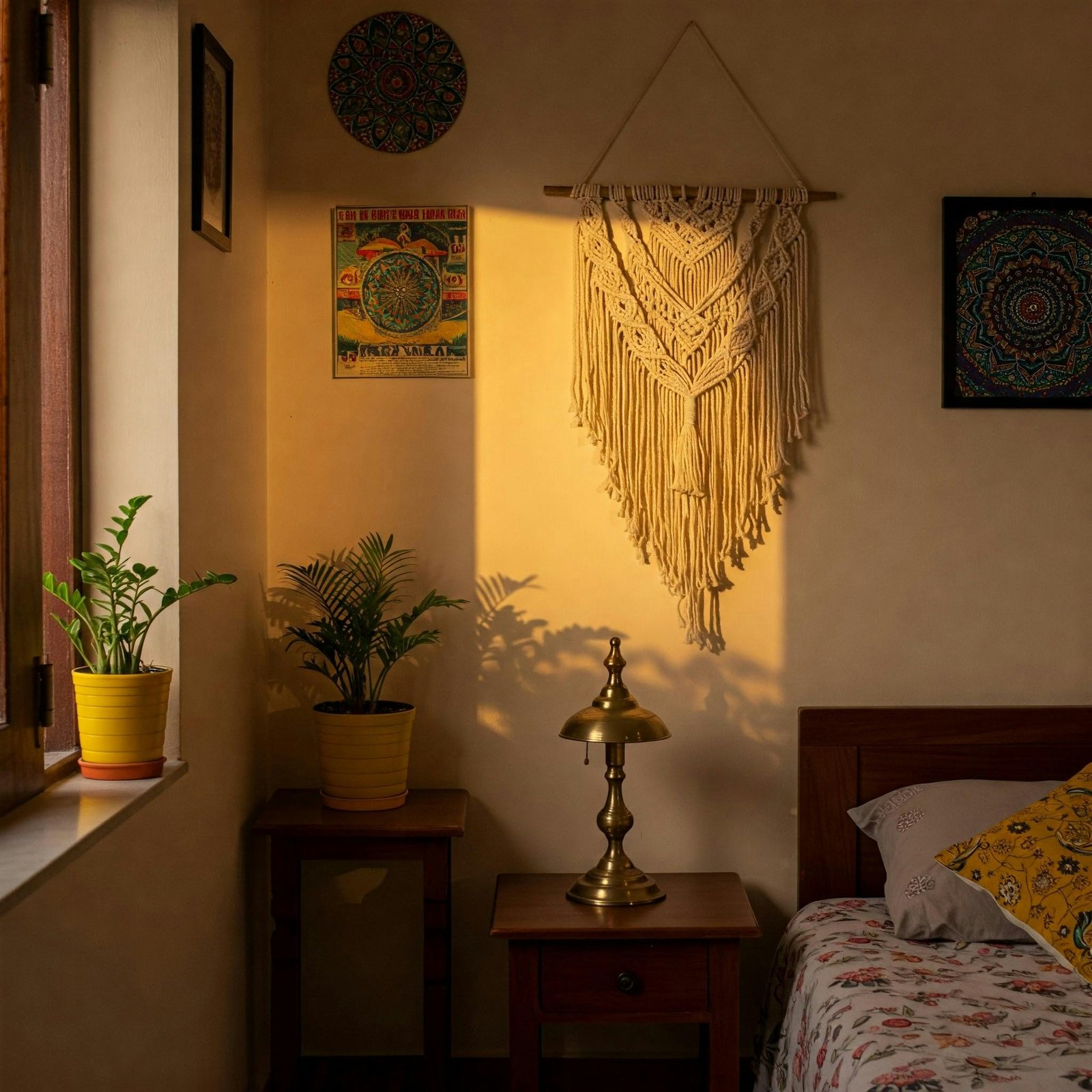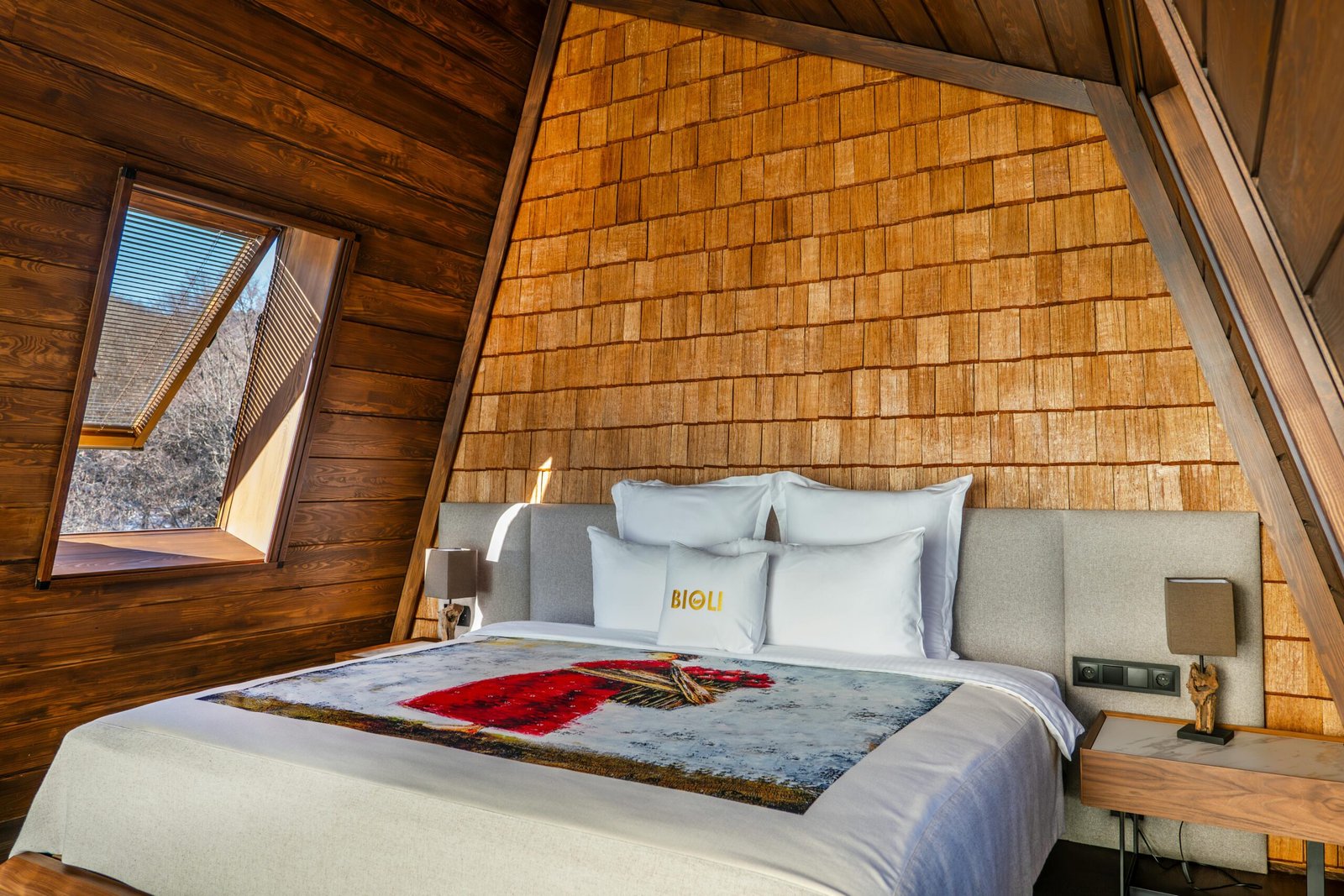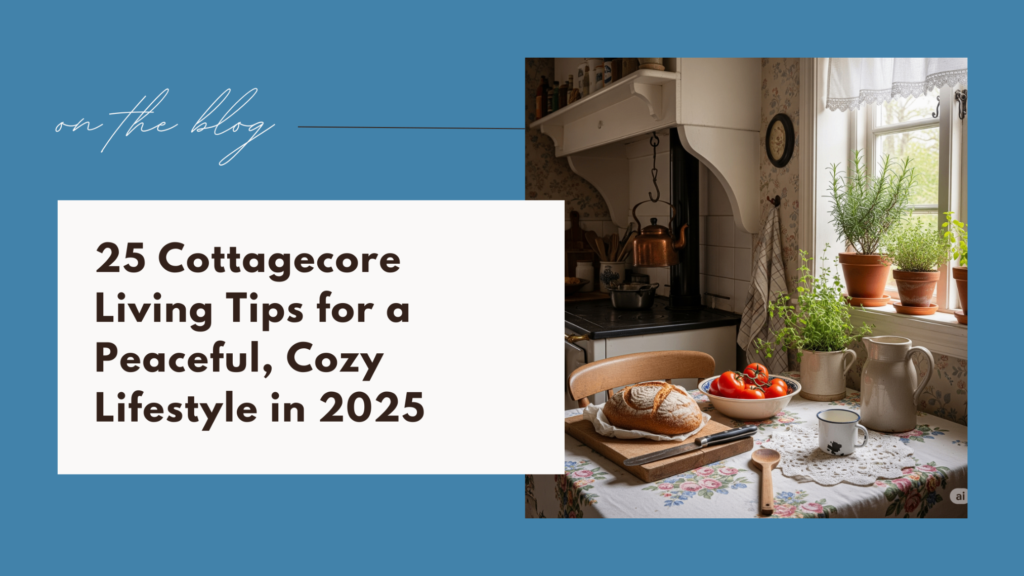Last spring, I felt completely overwhelmed by modern life’s constant rushing and digital noise. That’s when I discovered cottagecore living tips that transformed my entire approach to daily life. Now, my mornings begin with homemade bread baking in the oven, fresh herbs growing on my windowsill, and a sense of peace I never thought possible in our fast-paced world.
My Journey into Cottagecore Living
Two years ago, my small apartment felt sterile and disconnected from nature. I was constantly stressed, eating processed food, and felt like I was merely surviving rather than truly living. However, after stumbling upon cottagecore aesthetics on social media, I realized this wasn’t just about pretty pictures—it was a pathway to intentional, peaceful living.
Furthermore, I discovered that cottagecore isn’t about moving to the countryside or completely abandoning modern conveniences. Instead, it’s about bringing elements of rural simplicity, sustainability, and mindfulness into whatever space you call home.
Understanding the Heart of Cottagecore Philosophy

Cottagecore represents more than just an aesthetic—it’s a lifestyle philosophy centered on simplicity, sustainability, and connection to nature. The movement emphasizes slow living, handmade items, seasonal eating, and finding joy in everyday domestic activities.
Additionally, this lifestyle promotes mental wellness through mindful practices like gardening, baking, crafting, and spending time in nature. Research shows that these activities significantly reduce stress and improve overall life satisfaction.
Essential Cottagecore Living Elements for Your Home

Creating Your Cozy Sanctuary
The foundation of cottagecore living starts with transforming your space into a peaceful retreat. I began by decluttering ruthlessly, keeping only items that sparked joy or served a practical purpose. Then, I introduced natural materials like wood, linen, and clay to create warmth and texture.
Soft lighting became crucial—I replaced harsh overhead lights with table lamps, candles, and string lights. Consequently, my evenings became more relaxing, and I naturally started winding down earlier each night.
Natural Color Palette and Textures
Cottagecore spaces embrace earth tones, soft pastels, and plenty of cream and white. I painted my walls in warm sage green and added touches of dusty rose through textiles. Natural textures like woven baskets, wooden cutting boards, and vintage quilts add character and coziness.
Moreover, I discovered that these color choices affect mood—the soft, natural palette creates a calming environment that reduces anxiety and promotes relaxation.
25 Practical Cottagecore Living Tips for Daily Life

Kitchen and Cooking Transformation
1. Start Baking from Scratch Nothing embodies cottagecore like fresh-baked bread filling your home with warmth and comfort. I began with simple no-knead recipes and gradually expanded to sourdough and seasonal fruit tarts.
2. Preserve Seasonal Fruits Canning and preserving connect you to seasonal rhythms while providing homemade treats year-round. My pantry now showcases rows of homemade jams, pickles, and preserved fruits that taste infinitely better than store-bought versions.
3. Create a Functional Herb Garden Even in my small apartment, I maintain herbs on my windowsill. Fresh basil, rosemary, and thyme not only enhance cooking but also provide aromatherapy benefits and a connection to growing things.
4. Embrace Cast Iron Cooking Cast iron cookware lasts generations and improves with use. I cook everything from cornbread to roasted vegetables in my vintage cast iron pieces, which add authentic cottage charm to my kitchen.
5. Make Your Pantry Staples Simple items like granola, yogurt, and salad dressings taste better homemade and reduce packaging waste. Additionally, the process itself becomes meditative and satisfying.
Home Decoration and Ambiance

6. Display Fresh and Dried Flowers Weekly farmer’s market visits provide fresh flowers for my home, while dried bouquets last months and add rustic charm. Wildflowers and garden roses particularly capture the cottagecore aesthetic.
7. Use Vintage and Thrifted Items Second-hand treasures tell stories and add characters impossible to achieve with new items. My home features vintage teacups, antique books, and repurposed furniture that creates unique, personal spaces.
8. Create Reading Nooks Cozy reading corners with soft lighting and comfortable seating encourage slow, mindful living. My reading nook by the window has become my favorite space for morning coffee and evening relaxation.
9. Add Natural Elements Everywhere Wooden bowls, stone accents, and woven baskets bring nature indoors. These materials age beautifully and create warmth that synthetic items simply cannot match.
10. Make Your Candles Homemade soy candles with essential oils provide customized scents and eliminate harmful chemicals found in commercial candles. The process itself is therapeutic and creative.
Seasonal Living and Nature Connection
11. Follow Seasonal Rhythms I plan activities around natural seasons—spring cleaning, summer preserving, autumn crafting, and winter nesting. This approach creates anticipation and connection to natural cycles often lost in modern life.
12. Forage Responsibly Learning to identify edible plants and mushrooms deepens nature’s connection while providing unique ingredients. However, always research thoroughly and follow local regulations for safe foraging.
13. Create Seasonal Decorations Autumn brings pumpkins and dried leaves, and winter features evergreen boughs and pinecones. These natural decorations cost nothing but add authentic seasonal beauty throughout the year.
14. Start a Compost System Even apartment dwellers can compost using small containers or worm bins. This practice reduces waste while creating rich soil for plants, completing the natural cycle.
15. Practice Weather Awareness Instead of checking weather apps constantly, I observe clouds, wind patterns, and seasonal changes. This mindfulness practice connects me to natural rhythms and improves present-moment awareness.
Sustainable and Mindful Practices

16. Mend and Repair Instead of Replacing Learning basic sewing, darning, and repair skills extend item lifespans while providing meditative handwork. My visible mending projects have become decorative elements celebrating the beauty of repair.
17. Make Natural Cleaning Products Simple ingredients like vinegar, baking soda, and essential oils create effective cleaners without harsh chemicals. Moreover, the process saves money while protecting both health and the environment.
18. Develop Slow Morning Routines Rushing through mornings destroys peace before the day begins. I wake earlier to enjoy coffee, journal writing, and gentle stretching without time pressure.
19. Practice Gratitude for Simple Pleasures Cottagecore living emphasizes finding joy in everyday moments—warm tea, bird songs, or soft textiles. This mindset shift dramatically improves overall life satisfaction.
20. Create Handmade Gifts Homemade presents like knitted scarves, preserved foods, or painted pottery show thoughtfulness impossible to purchase. Additionally, crafting provides creative satisfaction and stress relief.
Wardrobe and Personal Style
21. Build a Capsule Wardrobe Quality natural fabrics in neutral colors create a timeless, versatile wardrobe aligned with cottagecore values. Linen dresses, wool sweaters, and cotton blouses form the foundation of my simplified wardrobe.
22. Learn Traditional Crafts Knitting, embroidery, and weaving provide both practical skills and meditative activities. These crafts connect us to generations of makers while creating useful, beautiful items.
23. Care for Items Properly Proper washing, storing, and maintaining clothes extends their lifespan significantly. Hand-washing delicate items and air-drying preserve fabrics while saving energy.
Community and Connection
24. Share with Neighbors Trading homemade goods, sharing garden produce, and helping neighbors create community connections often missing in modern life. These relationships provide support and friendship.
25. Document Simple Moments Keeping a gratitude journal or photo diary of daily beauty helps maintain an appreciation for cottagecore living’s simple pleasures. This practice reinforces positive lifestyle changes.
User Queries from Online Platforms
Based on discussions from Reddit r/cottagecore and Quora lifestyle communities, here are common questions I encounter:
How do I start cottagecore living in a small apartment?
Focus on what you can control—color palette, natural textures, plants, and handmade items. I transformed my 500-square-foot apartment using these principles without major renovations.
Is cottagecore living expensive to implement?
It’s quite budget-friendly since it emphasizes thrifting, making things yourself, and buying less overall. Most of my cottagecore elements came from thrift stores, nature, or my own hands.
Can working professionals maintain this lifestyle?
Absolutely! I work full-time and maintain cottage-core elements through small daily practices—morning bread baking, evening crafting, and weekend nature activities. It’s about mindset more than time.
How do I convince family members to embrace simpler living?
Lead by example rather than preaching. When the family sees how much happier and more peaceful you become, they naturally become curious about your lifestyle changes.
The Mental Health Benefits of Cottagecore Living

Research from the University of Rochester demonstrates that engaging with nature and handcrafts significantly reduces cortisol levels and improves mood. Additionally, studies show that slow-living practices decrease anxiety and increase life satisfaction.
The mindfulness inherent in cottagecore living tips creates natural meditation opportunities throughout the day. Whether kneading bread, tending plants, or hand-sewing, these activities require present-moment focus that quiets mental chatter and reduces stress.
Creating Your Cottagecore Rhythm
Every successful cottagecore lifestyle must reflect your unique circumstances and preferences. Start by identifying which elements resonate most strongly with you—perhaps it’s cooking from scratch, crafting, or connecting with nature.
Moreover, remember that cottagecore living is a gradual transformation, not an overnight change. I implemented one new practice monthly, allowing each to become a habit before adding another. This approach prevents overwhelm while ensuring lasting change.
Seasonal Cottagecore Activities Throughout the Year
Spring Awakening
Spring brings energy for deep cleaning, garden planning, and fresh starts. I spend time outdoors collecting wildflowers, starting seedlings, and opening windows to welcome fresh air into my home.
Summer Abundance
Summer focuses on preserving abundance through canning, drying herbs, and enjoying long days in nature. Picnics, berry picking, and evening garden time become regular practices.
Autumn Preparation
Fall emphasizes preparation and gratitude—harvesting, crafting for winter, and creating cozy spaces. This season brings the most quintessentially cottagecore activities like apple picking and wreath making.
Winter Reflection
Winter encourages inward focus through reading, crafting, and hearty cooking. Long evenings provide perfect opportunities for handwork and planning next year’s garden.
Common Challenges and Solutions
Perfectionism in Aesthetics
Social media can create unrealistic expectations about cottagecore living. However, I’ve learned that authenticity matters more than perfect aesthetics. My home shows signs of actual living—flour on counters, well-loved books, and plants that aren’t always perfectly arranged.
Balancing Modern Responsibilities
Cottagecore living doesn’t mean abandoning all modern conveniences or responsibilities. Instead, it’s about being intentional about which modern elements serve your well-being and which detract from it.
Time Management Concerns
Many people worry they don’t have time for cottagecore practices. However, I’ve found that slowing down creates more time by reducing rushing and increasing satisfaction with daily activities.
Building Community Around Cottagecore Values
Local Connections
Farmer’s markets, craft fairs, and community gardens provide opportunities to meet like-minded people who share cottagecore values. These connections often develop into friendships based on shared interests in simple living.
Online Communities
Social media groups and forums offer inspiration and support for cottagecore living. However, I limit online time to prevent comparison and maintain focus on my journey.
Teaching and Sharing Skills
Sharing knowledge about traditional skills strengthens community bonds while preserving important crafts. I’ve taught neighbors bread baking and learned canning techniques from experienced friends.
FAQs
Do I need to live in the countryside to practice cottagecore living?
Not at all! I live in a city apartment and successfully incorporate cottagecore elements through plants, natural materials, handmade items, and mindful practices. Location matters less than intention.
How much money do I need to start living the cottagecore lifestyle?
Cottagecore living can save money since it emphasizes making things yourself, buying less, and using what you have. Start with free activities like foraging, thrifting, and learning new skills.
Is cottagecore living just for women?
Not! Cottagecore principles of simplicity, sustainability, and craftsmanship appeal to people of all genders. Many men embrace woodworking, gardening, and cooking as part of their cottagecore lifestyle.
Advanced Cottagecore Living Strategies
Developing Food Preservation Skills
Learning to can, ferment, and dehydrate foods extends seasonal eating year-round while developing self-sufficiency skills. These methods also preserve peak flavors better than store-bought alternatives.
Creating Natural Dye Projects
Using plants to dye fabrics connects you to traditional methods while creating unique, personalized items. Onion skins, avocado pits, and turmeric provide beautiful natural colors.
Building Relationships with Local Producers
Developing relationships with farmers, artisans, and makers in your community supports the local economy while providing access to high-quality, handmade goods.
The Future of Cottagecore Living
As more people seek alternatives to fast-paced modern life, cottage-core living tips provide practical solutions for creating peace and meaning in daily routines. This lifestyle trend represents a broader movement toward sustainability, mindfulness, and authentic living.
Furthermore, cottagecore principles align with growing awareness about mental health, environmental responsibility, and the importance of slowing down. These values will likely become increasingly relevant as society seeks balance in our digital age.
Conclusion: Embracing Your Cottagecore Journey
My transformation through cottagecore living tips has been gradual but profound. What started as aesthetic inspiration became a complete lifestyle philosophy that brings daily joy and peace to my life. The key is starting small and building sustainable practices that align with your values and circumstances.
Remember, cottagecore living isn’t about perfection or comparison with others. It’s about creating a life that feels authentic, peaceful, and connected to the natural world around you. Whether you live in a cottage or a city apartment, these principles can transform your daily experience.
The beauty of cottagecore lies in its accessibility—anyone can begin incorporating these practices immediately. Start with one element that appeals to you most, whether it’s baking bread, growing herbs, or simply slowing down your morning routine.
Your journey toward peaceful, intentional living begins with a single step. Choose one cottagecore living tip from this guide and implement it this week. Notice how it affects your mood, stress levels, and overall satisfaction with daily life.
The path to a more peaceful 2025 starts now, one mindful moment at a time. Trust in the process, embrace imperfection and allow cottage-core principles to guide you toward the life you’ve been seeking.


